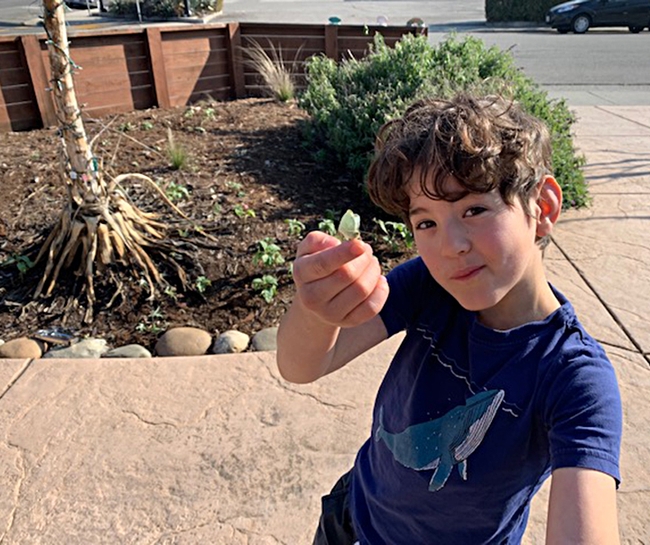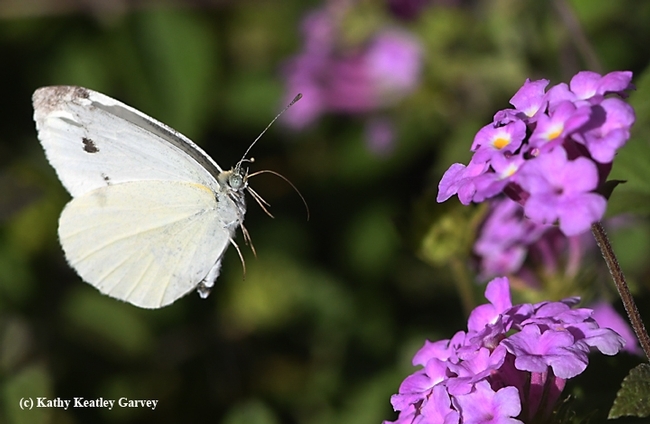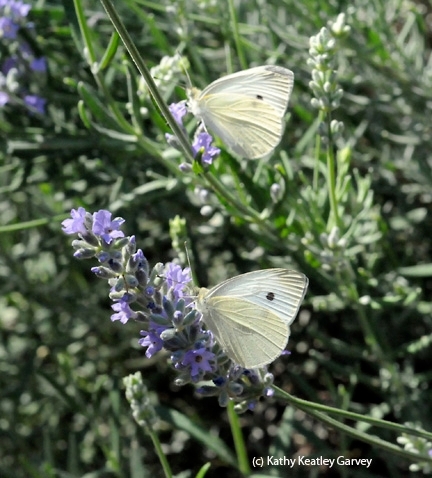- Author: Kathy Keatley Garvey

He participates in his annual "Beer for a Butterfly" contest that he's sponsored since 1972 as part of his scientific research to determine the butterfly's first flight of the year in the three-county area of Sacramento, Yolo and Solano. The rules: net the first butterfly and win a pitcher of beer or its equivalent. Suds for a bug.
Today, Feb. 8, proved to be a "bingo" day.
"I knew when I left the house at 10:10 this morning that today would be rapae day," he announced in an email with the subject line, Bingo!
"It was."
He spotted his first rapae of the year, a female, at 11:22 a.m. in West Sacramento, Yolo County. At 11:38, he saw a male. "Both were typical late winter phenotypes, quite different from what was flying in December," he noted. "My last in West Sac was Christmas Eve. So the rapae-less hiatus was 45 days, i.e. just over 6 weeks."
It was 64 degrees, clear, no wind.
"I did not get a specimen," Shapiro related. "Both of them were flying up near the railroad track at the top of the railroad embankment, where the ground is strewn with coarse gravel. That makes for a warm layer of air in full sun, but terrible footing. I am no longer so nimble or so self-confident as I used to be, and I never got a clean shot at either bug even though I got within about 6 feet of both."
"I could have stayed in that area and probably eventually would have caught one or both of them," Shapiro added. "I had to weigh that against covering the rest of the upland half of my site and possibly finding something else out. Remember that the butterfly-friendly window of time each day is still very short. I opted to keep moving, ultimately observing two atalanta (Vanessa atalanta, the red admiral) but nothing else. Malvella (mallow family) has not broken ground yet. Plenty of Erodium (family Geraniaceae) in bloom now, though.
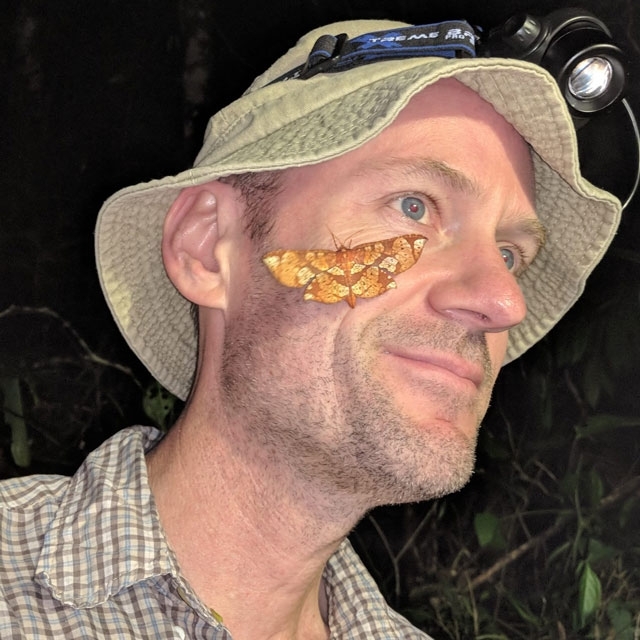
P. rapae inhabits vacant lots, fields and gardens where its host plants, weedy mustards, grow. In its caterpillar stage, it is a pest commonly called "cabbageworm" that chews on cole crops.
Shapiro, who is in the field 200 days of the year, has been defeated only four times and those were by UC Davis graduate students. Adam Porter won in 1983; Sherri Graves and Rick VanBuskirk each won in the late 1990s; and Jacob Montgomery in 2016. The first three were his own graduate students.
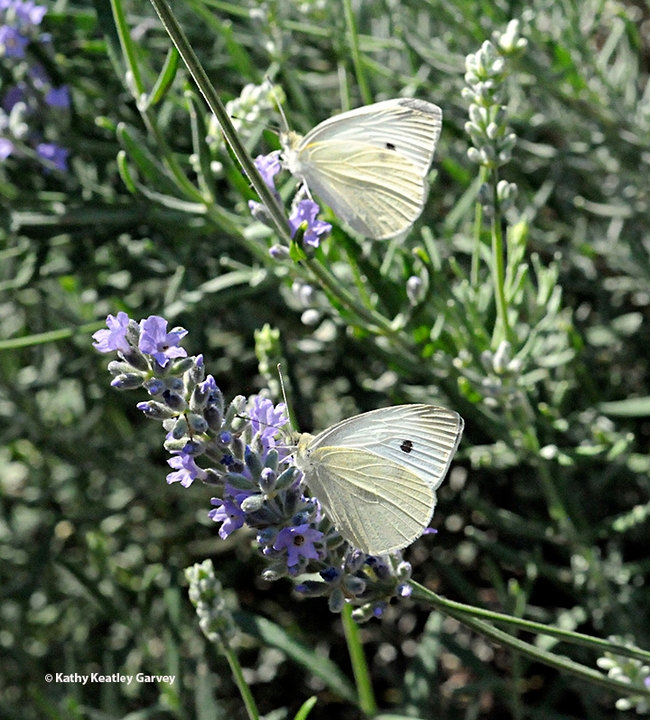
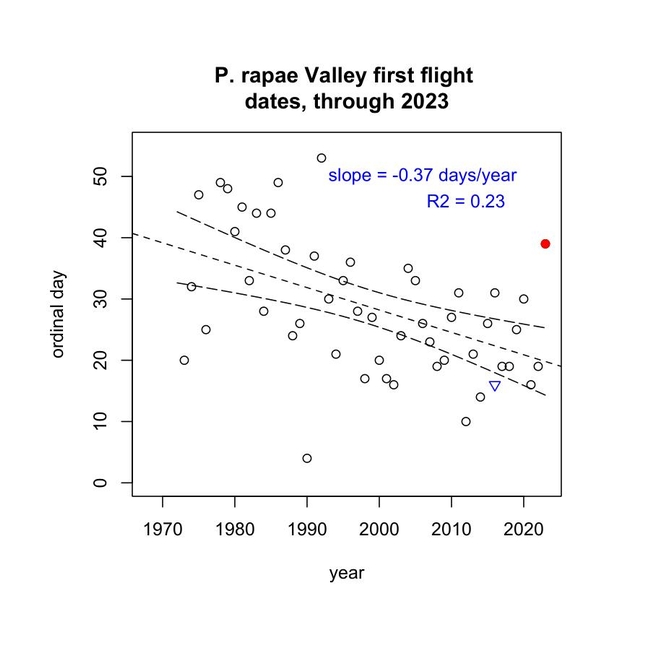
- Author: Kathy Keatley Garvey
Blame the rain. Blame the cold.
As of today, Jan. 26, no one has won Art Shapiro's "Beer-for-a-Butterfly Contest," aka Suds-for-a-Bug.
Not Art, not anyone.
Shapiro, a UC Davis distinguished professor of evolution and ecology, has sponsored the Beer-for-a-Butterfly Contest since 1972 in the three-county area of Sacramento, Yolo and Solano to determine the cabbage white butterfly's first flight of the year.
It's part of his long-term studies of butterfly life cycles and climate change. He's been researching butterfly populations of central California since 1972 and posts information on his website, Art's Butterfly World.
How does this contest work? He'll trade you a pitcher of beer or its equivalent if you collect the first cabbage white butterfly, Pieris rapae, of the year.
But he usually wins because he knows where to look.
Shapiro went looking for the bug today, which he described as "a perfect rapae day."
Any results? "Nope."
The contest rules include:
- It must be an adult (no caterpillars or pupae) and be captured outdoors.
- It must be brought in alive to the Department of Evolution and Ecology office, 2320 Storer Hall, UC Davis, during work hours, 8 a.m. to 5 p.m., Monday through Friday, with the full data (exact time, date and location of the capture) and the contact information of the collector (address, phone number and/or e-mail.) The receptionist will certify that it is alive and refrigerate it. (If it's collected on a weekend or holiday, it can be kept in the refrigerator for a few days--do not freeze it.)
- Shapiro is the sole judge.
P. rapae inhabits vacant lots, fields and gardens where its host plants, weedy mustards, grow. The male is white. The female is often slightly buffy; the "underside of the hindwing and apex of the forewing may be distinctly yellow and normally have a gray cast,” Shapiro said. “The black dots and apical spot on the upperside tend to be faint or even to disappear really early in the season.” In its caterpillar stage, it is a pest commonly called "cabbageworm."
Shapiro, who is in the field 200 days of the year, has been defeated only four times and those were by UC Davis graduate students. Adam Porter won in 1983; Sherri Graves and Rick VanBuskirk each won in the late 1990s; and Jacob Montgomery in 2016. The first three were his own graduate students.
The search is on...Rumor has it that Ria de Grassi of Davis, who won the third annual Robbin Thorp First-Bumble-Bee-of-the-Year Contest by photographing a black-tailed bumble bee, Bombus melanopygus, in her yard, may try her hand (and her net) at collecting one. (See Bug Squad blog)
Shapiro loves the competition, all of it. "Let the best person win!"
Anyone?
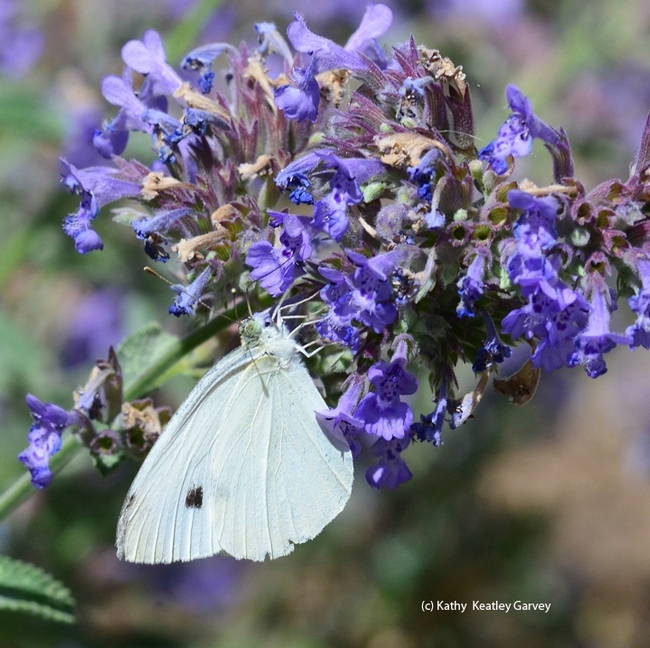
- Author: Kathy Keatley Garvey
To catch a cabbage white butterfly...
It was early October and a gravid praying mantis, almost ready to deposit her ootheca, was hungry.
She crawled behind a cactus in our yard, waiting for prey.
It did not take long. A cabbage white butterfly, Pieris rapae, fluttered down and made the fatal mistake of landing right next to Ms. Mantis.
The rest, they say, is...dinner.
Cabbage whites are in the news now because UC Davis distinguished professor Art Shapiro is sponsoring his annual Beer-for-a-Butterfly Contest. If you collect the first cabbage white of the year in the three-county area of Sacramento, Yolo and Solano, you'll get a pitcher of beer, or its equivalent.
Shapiro, a member of the Department of Evolution and Ecology faculty, has sponsored the “Suds for a Bug” contest since 1972 to determine the butterfly's first flight of the year. He launched the contest as part of his long-term studies of butterfly life cycles and climate change. P. rapae is emerging earlier and earlier as the regional climate has warmed, said Shapiro. "Since 1972, the first flight of the cabbage white butterfly has varied from Jan. 1 to Feb. 22, averaging about Jan. 20." (See Bug Squad for contest details.)
Note that the cabbage white butterfly is not an insect to treasure. As a caterpillar, P. rapae is a major pest of cole crops such as cabbage. UC Statewide Integrated Pest Management Program (UC IPM) says the cabbageworm is active throughout the year in California. "Cabbageworm larvae chew large, irregular holes in leaves, bore into heads, and drop greenish brown fecal pellets that may contaminate the marketed product. Seedlings may be damaged, but most losses are due to damage to marketed parts of the plant," according to the UC IPM website.
Indeed, if you grow cole crops, you're probably ecstatic about a praying mantis nailing a pest.
This mantis is a Stagmomantis limbata, as identified by Lohit Garikipati, a UC Davis alumnus studying for his master's degree at Towson University, Md.
A predator and a prey.
On a wing and a prayer.
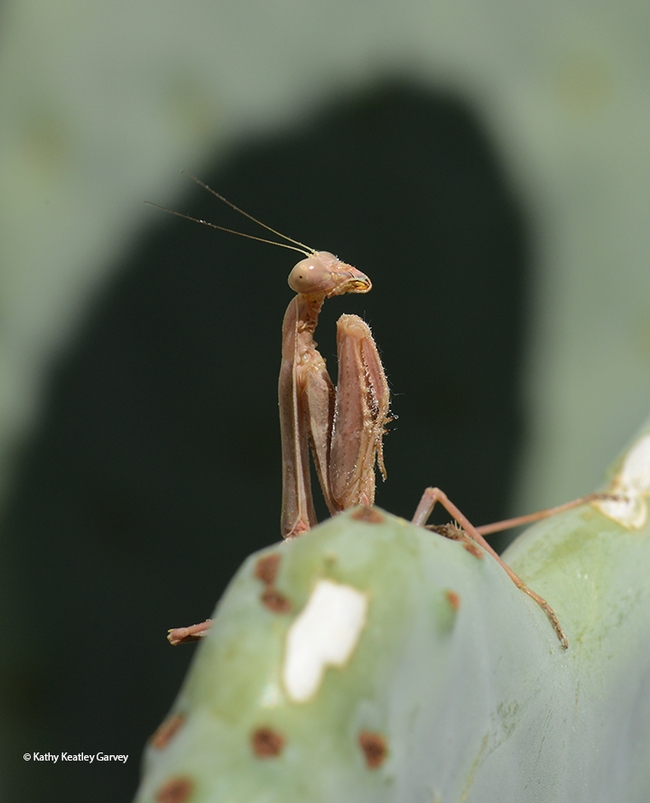
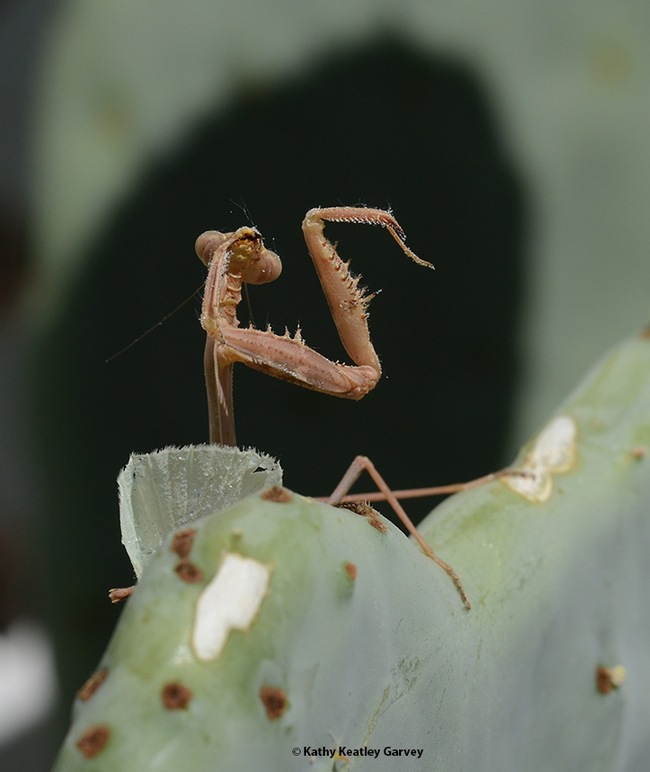
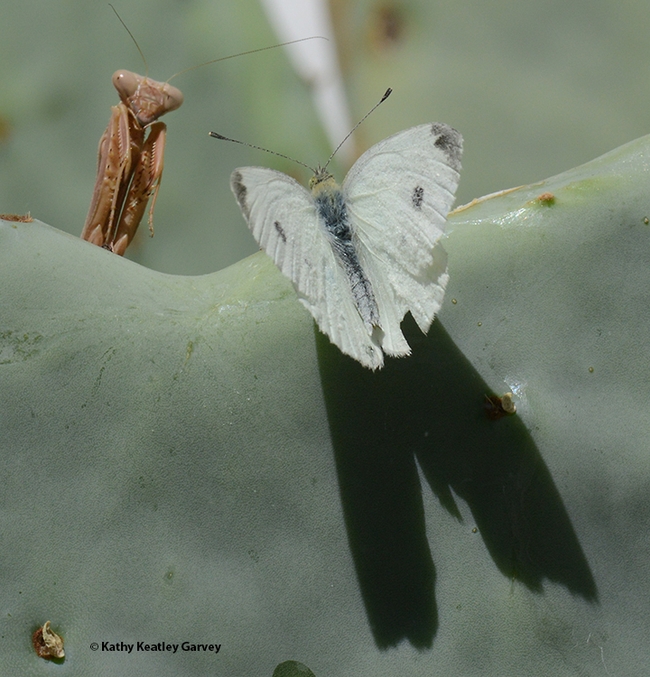
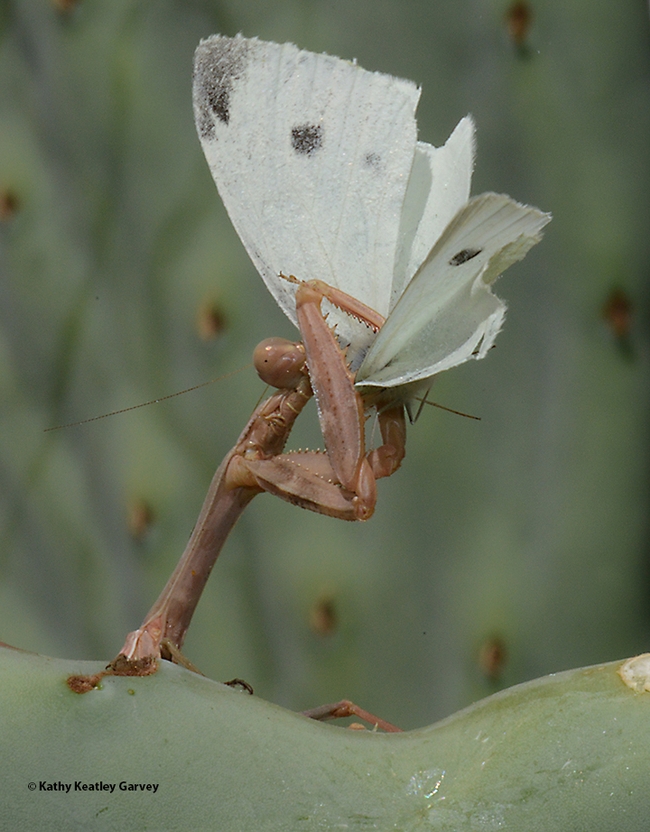
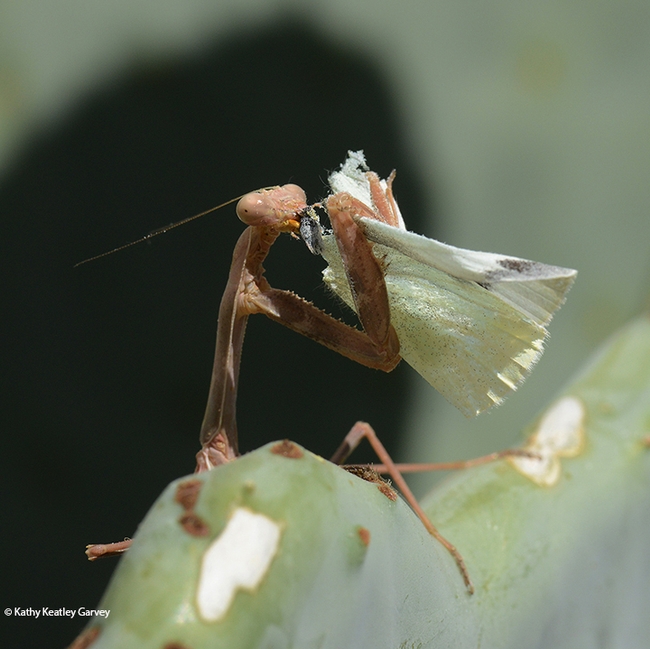
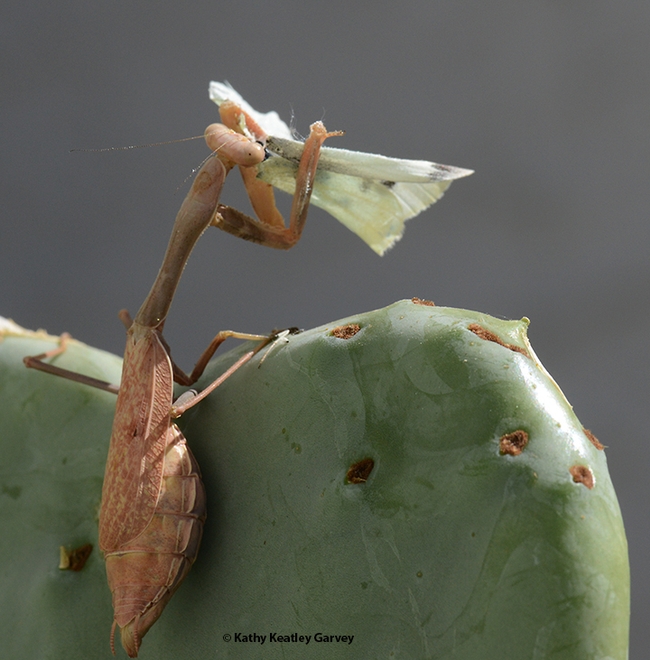
- Author: Kathy Keatley Garvey
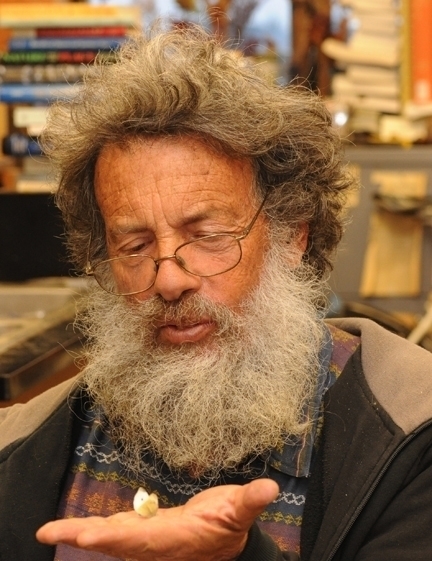
“It's of special interest this year because as of a few days ago the bug was still flying and laying eggs, which will result in non-diapause pupae,” said Shapiro, a noted butterfly expert who researches biological responses to climate change. “Depending on the weather, that could mean an earlier-than-usual emergence. There is even a slight chance the fall brood is not over yet...”
Shapiro, a member of the Department of Evolution and Ecology faculty, has sponsored the “Suds for a Bug” contest since 1972 to determine the Pieris rapae's first flight of the year in the three-county area of Sacramento, Solano and Yolo. He launched the contest as part of his long-term studies of butterfly life cycles and climate change.
P. rapae is emerging earlier and earlier as the regional climate has warmed, said Shapiro. "Since 1972, the first flight of the cabbage white butterfly has varied from Jan. 1 to Feb. 22, averaging about Jan. 20."
Shapiro, who has monitored butterfly populations of central California since 1972 and maintains a research website at http://butterfly.ucdavis.edu/, says the point of the contest "is to get the earliest possible flight date for statistical purposes. The rules require that the animal be captured and brought in alive to be verified. That way no one can falsely claim to have seen one or misidentify something else as a cabbage white."
The contest rules include:
- It must be an adult (no caterpillars or pupae) and be captured outdoors.
- It must be brought in alive to the Department of Evolution and Ecology office, 2320 Storer Hall, UC Davis, during work hours, 8 a.m. to 5 p.m., Monday through Friday, with the full data (exact time, date and location of the capture) and the contact information of the collector (address, phone number and/or e-mail.) The receptionist will certify that it is alive and refrigerate it. (If it's collected on a weekend or holiday, it can be kept in the refrigerator for a few days--do not freeze it.)
- Shapiro is the sole judge.
The professor said P. rapae inhabits vacant lots, fields and gardens where its host plants, weedy mustards, grow. The male is white. The female is often slightly buffy; the "underside of the hindwing and apex of the forewing may be distinctly yellow and normally have a gray cast,” Shapiro said. “The black dots and apical spot on the upperside tend to be faint or even to disappear really early in the season.”
Shapiro, who monitors butterfly populations in the field for more than 200 days of the year, usually wins the contest. He has been defeated only four times and those were by UC Davis graduate students. Adam Porter won in 1983; Sherri Graves and Rick VanBuskirk each won in the late 1990s; and Jacob Montgomery in 2016. The first three were his own graduate students.
A fellow of the American Association for the Advancement of Science, the Royal Entomological Society and the California Academy of Sciences, Shapiro is the author of A Field Guide to Butterflies of the San Francisco Bay and Sacramento Valley Regions, illustrated by Tim Manolis and published in 2007 by the University of California Press
Recent Beer-for-a-Butterfly Contest statistics:
- 2022: No official contest due to the COVID pandemic, but Shapiro recorded his first-of-the-year P. rapae at 1:25 p.m. on Jan. 19 in West Sacramento, Yolo County
- 2021: No official contest due to the COVID pandemic, but Shapiro collected his first-of-the-year at 1:55 p.m. Jan. 16 on the UC Davis campus, Yolo County
- 2020: Technically, no winner, as Shapiro did not collect the one he spotted in Winters, Yolo County at 11:16 a.m. on Jan. 30 at the Putah Creek Nature Park. "It flew back and forth across Putah Creek and then departed the area, flying out of reach above the trees," he noted. He waited around for 90 minutes to see if it would return. It did not.
- 2019: Shapiro collected the first cabbage white butterfly near the Suisun Yacht Club, Suisun City, Solano County, at 1:12 p.m., Friday, Jan. 25. "It was the earliest recorded in Suisun City in 47 seasons."
- 2018: Art Shapiro collected the winner in West Sacramento
- 2017: Jan. 19: Art Shapiro collected the winner on the UC Davis campus
- 2016: Jan. 16: Jacob Montgomery collected the winner in west Davis
- 2015: Jan. 26: Shapiro collected the winner in West Sacramento
- 2014: Jan. 14: Shapiro collected the winner in West Sacramento
- 2013: Jan. 21: Shapiro collected the winner in West Sacramento
- 2012: Jan. 8: Shapiro collected the winner in West Sacramento
- 2011: Jan. 31: Shapiro collected the winner in Suisun
- 2010: Jan. 27: Shapiro collected the winner in West Sacramento
Shapiro nets many of the winners in mustard patches near railroad tracks in West Sacramento, Yolo County.
As a caterpillar, the insect is a pest of cole crops such as cabbage. UC Statewide Integrated Pest Management Program (UC IPM) says the cabbageworm is active throughout the year in California. "Cabbageworm larvae chew large, irregular holes in leaves, bore into heads, and drop greenish brown fecal pellets that may contaminate the marketed product. Seedlings may be damaged, but most losses are due to damage to marketed parts of the plant," according to the UC IPM website.
Related Link:
Research Publication on Non-Diapause Overwintering Cabbage White Butterfly and Anise Swallowtail
Non-Diapause Overwintering by Pieris rapae (Lepidoptera: Pieridae) and Papilio zelicaon (Lepidoptera: Papilionidae) in California: Adaptiveness of Type III Diapause-Induction Curves by Art Shapiro, published in 1984 in Psyche: A Journal of Entomology (open access article)
First paragraph: "Diapause is generally regarded as a physiological adaptation which increases the probability of surviving the adverse season, and thus of reproducing after it is over. Many insect species show geographic differences in the environmental regimes which induce or inhibit diapause (e.g., critical photoperiod) and in the strength of the diapause induced. Such interpopulational differences are commonly viewed as "fine tuning" to local climates, accomplished by natural selection and reflecting a genetic basis (e.g., Istock, 1981). Intrapopulational differences in photoperiodic sensitivity and diapause strength (e.g., chilling requirement) also occur, and have been interpreted as polymorphisms which "spread the risk" of environmental uncertainty over the population (cf. Bradshaw 1973, Shapiro 1979, 1980a). In multivoltine insects in seasonal climates, offspring produced by the last seasonal generation of adults are commonly induced to enter diapause by specific combinations of environmental factors; in mid-latitudes these are likely to be decreasing photophase/increasing scotophase and decreasing or consistently low night temperatures. Warmer nights tend to shorten the critical photoperiod for a given population, or may effectively inhibit diapause altogether under field conditions." (See more)
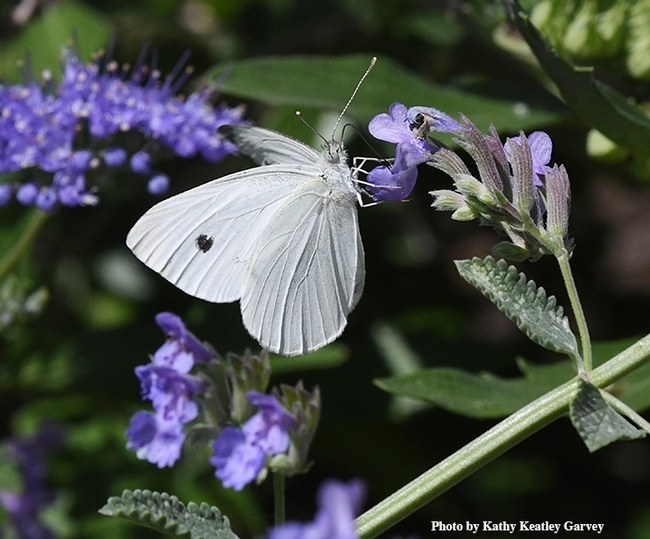
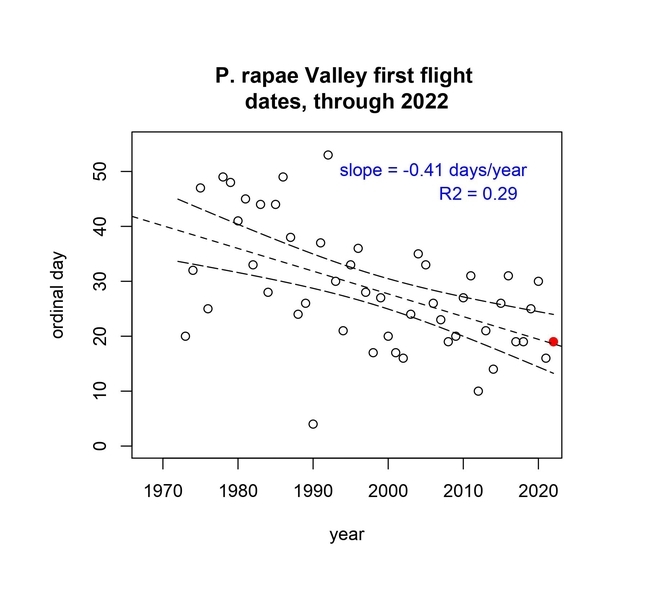
- Author: Kathy Keatley Garvey
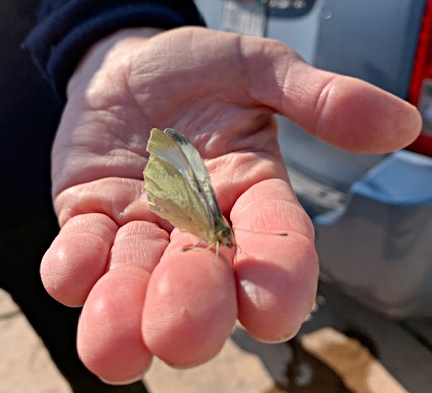
Asher Schneider, a budding entomologist who attends Eliza Sater's second-third grade class at Birch Lane Montessori, Davis, found a cabbage white butterfly, Pieris rapae, at 10:54 a.m., Sunday, Jan. 23 on M Street, Davis.
Asher, the son of Rachel White and Ben Crago-Schneider, spotted the butterfly on salvia (sage). "Sadly this guy looked like he didn't have much time left," White said. "He was just kind of flopping around on the sage."
The family remembered reading about the annual contest in The Davis Enterprise, and emailed a photo to Shapiro.
Shapiro, clearly delighted in the youth's participation in what would have been the 50th annual contest (canceled the last two years due to the COVID pandemic precautions) promptly named him "runner-up."
The first of 2022? Shapiro recorded a P. rapae in West Sacramento at 1:25 p.m. on Wednesday, Jan. 19.
"Pop goes the Pieris!" Shapiro emailed to his colleagues and friends.
Jan. 19 was the day that his colleague-collaborator Matt Forister, the Trevor McMinn Endowed Professor in Biology, Foundation Professor, at the University of Nevada, calculated it would be sighted. Forister, who received his doctorate in ecology (2004) from UC Davis, studying with Shapiro, creates "The First Flight Date" graphs. "And.... as if we had coordinated efforts (which we didn't), here's the graph!" Forister wrote in an email. "Art, you nailed it right on the regression line this time, you deserve an extra beer."
The contest involves collecting the first cabbage white butterfly of the year in the three-county area of Yolo, Sacramento and Solano. The traditional rules: Catch a live cabbage white butterfly in the wild in one of those three counties, deliver it live to Shapiro's department in Storer Hall, UC Davis (with the full data, exact time, date and location of the capture) and if it's the first of the year, the winner receives a pitcher of beer or its equivalent.
Last year Shapiro collected the first of the year in a "non-contest" at 1:55 p.m. Jan. 16 on the UC Davis campus.
Since 1972, the first flight of the cabbage white has varied from Jan. 1 to Feb. 22, averaging about Jan. 20. Shapiro says with climate warming, the species is now emerging a week or so earlier on average than it did 30 years ago here.
P. rapae inhabits vacant lots, fields and gardens where its host plants, weedy mustards, grow. The male is white. The female is often slightly buffy; the "underside of the hindwing and apex of the forewing may be distinctly yellow and normally have a gray cast,” Shapiro says. “The black dots and apical spot on the upperside tend to be faint or even to disappear really early in the season.”
Shapiro has monitored butterfly population trends on transects across central California since 1972 and maintains a research website at http://butterfly.ucdavis.
In its larval form, the cabbage white butterfly, known as "the imported cabbageworm," is a pest of cole crops. "Cabbageworm larvae chew large, irregular holes in leaves, bore into heads, and drop greenish brown fecal pellets that may contaminate the marketed product," according to the UC Statewide Integrated Pest Management Program. "Seedlings may be damaged, but most losses are due to damage to marketed parts of the plant."
